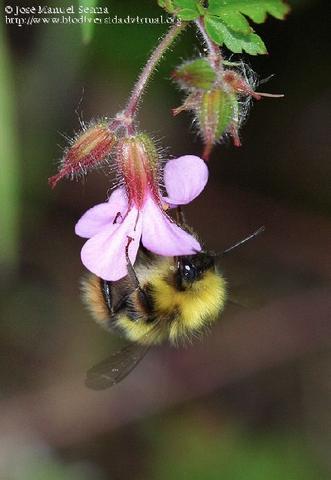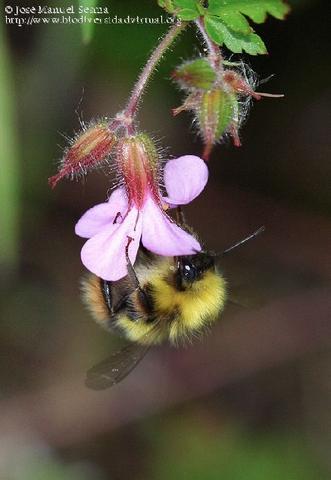Bombus pratorum
Bombus pratorum is a species with three European species. In the Iberian Península there is just one, Bombus pratorum ssp. santonae (Tkalcu, 1985).
It is a small size species.
Females: 15-18 mm.
Males: 11-13 mm.
Black head and thorax. The thorax has the collar and the scutellum yellow. Yellow T1 and T2. Black T3 and T4' sides. Yellowish red gaster. Black or brown legs. Long hairs.

It has not been evaluated.
No threats described.
Females: shor head. Square malar space, longer than A3 but shorter than A2+3. Genas with a dorsal groove. Flattened labral tubers, more prominent before the labral groove, which is very narrow. Elongated and prominent clypeus, with lateral impression well defined. Wide lateral impressions, with big points. Bright, little sculpted front, with well defined smooth areas. On the hind legs, crosslinked tibia, with dorsal angle little marked. T6 with a dense and fine dotted.
Genitalia: narrowprojections of the sting case little dilated in the upper region external. Very narrow internal projections, wider at the inner region.
Males: elongated head. Malar space as A2+3. Very long adn dense mandibular beard. Middle size antennas, where A3 is the same size than A5. Long and parallel sides middle legs basitarsus. On the hind legs, convex, pubescence and bright tibia's external face, The basitarsus has the dorsal angle slightly sharpened. Elongated E8, with rectilineal distal edge.
Genitalia: longer than wide. Long, sickle and convergent sagittae, with a sawn portion in the inner region and with a middle tooth, which bordering a large and elongated concavity. Little escuamas, with astraight internal edge. Small volselas, but its protrudes from the escuamas and extend in two points in its apical region.
Bombus pratorum appears in the mountain systems of the northern half of the peninsula. Also it appears in the Sierras de Cazorla and Baza, In the most southwestern towns in the provinces of Caceres and Coimbra.
600-1920 m.
Potential distribution map at the present time
Potential distribution map in 2050 with the same level of pollution emission and the climate changes consequence of these contamination levels
Map legend
Maps are made with GBIF data of this specie in Iberian Peninsula
Emergence from hibernation : late March
Flight period: April/ February - last September.
Small colonies. Nests between mosses, underground, in bird nests, walls, etc.
Bombus pratorum has been collected in Fabaceae, Asteraceae, Campunulaceae, Ranunculaceae, Ericaceae, Rosaceae, Geraniaceae.
This species has been collected by malaise trap.
BIotopes: mainly forest, but also undergrowth, meadows, pastures, gardens, roadsides and steppe zones.
